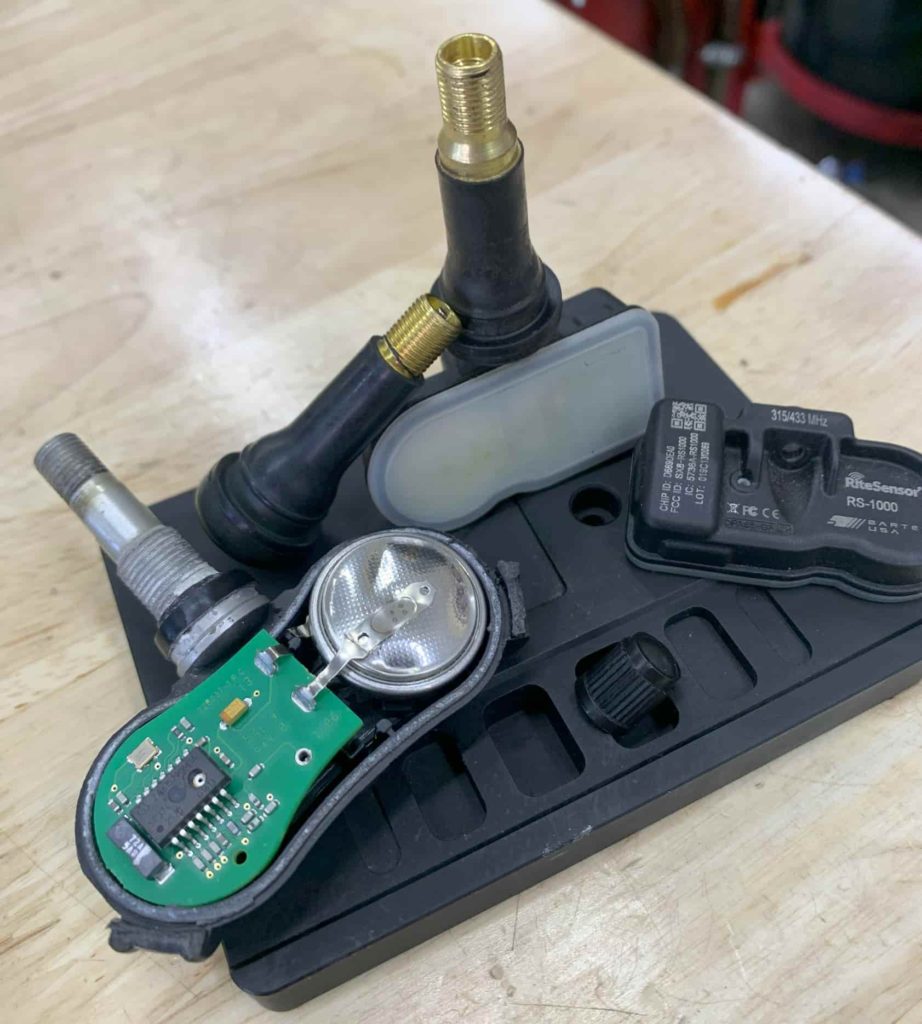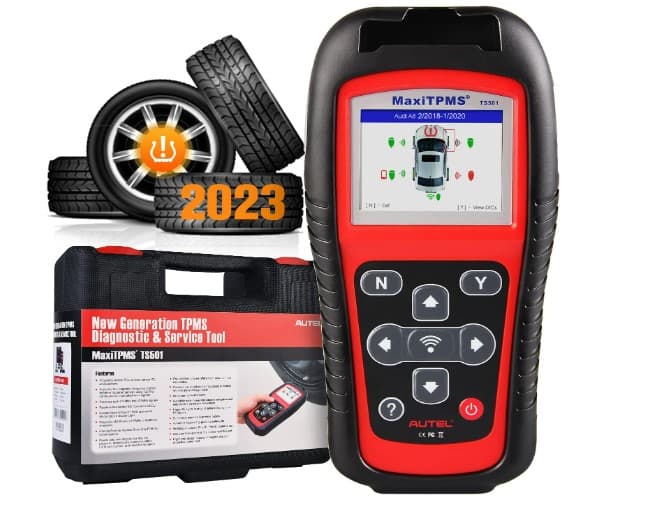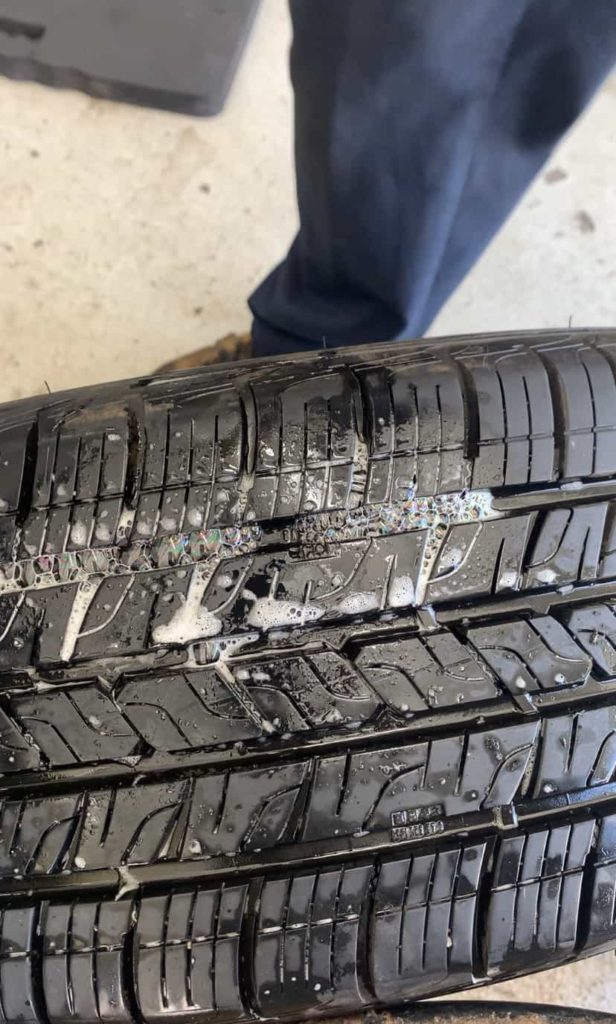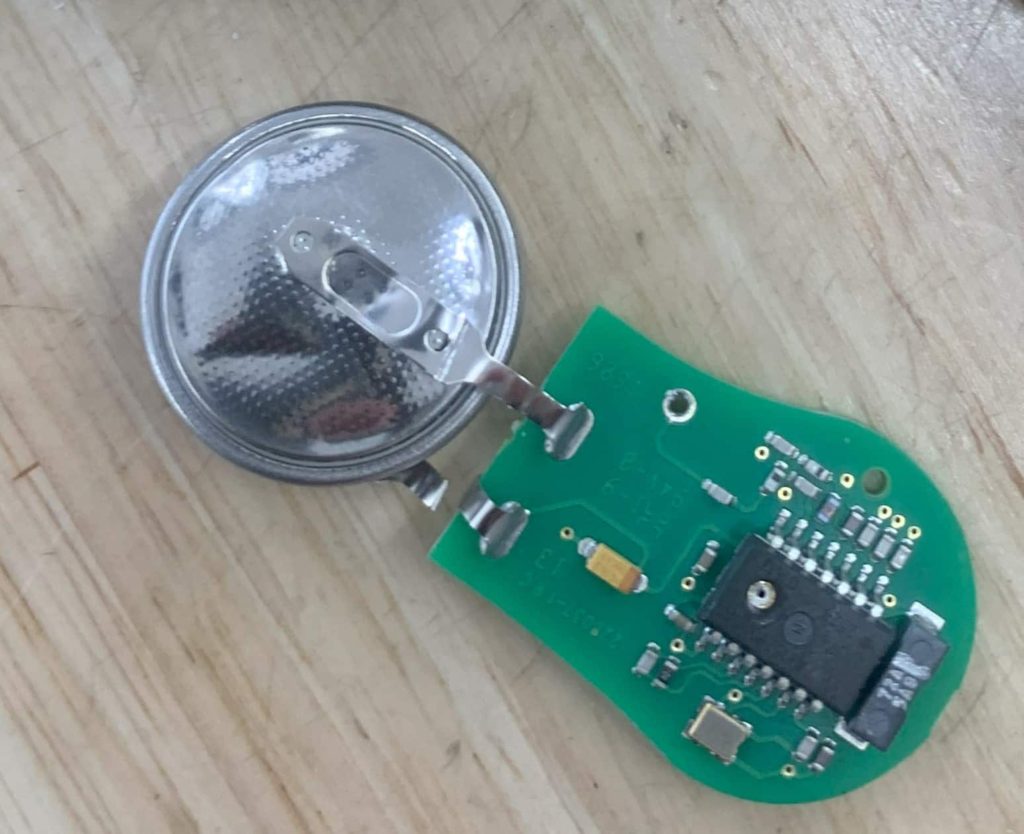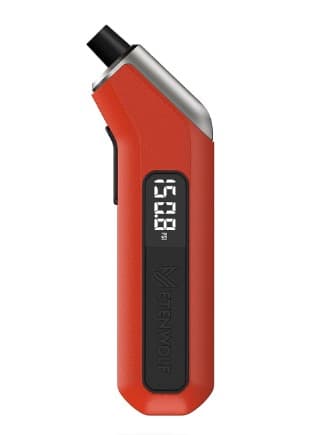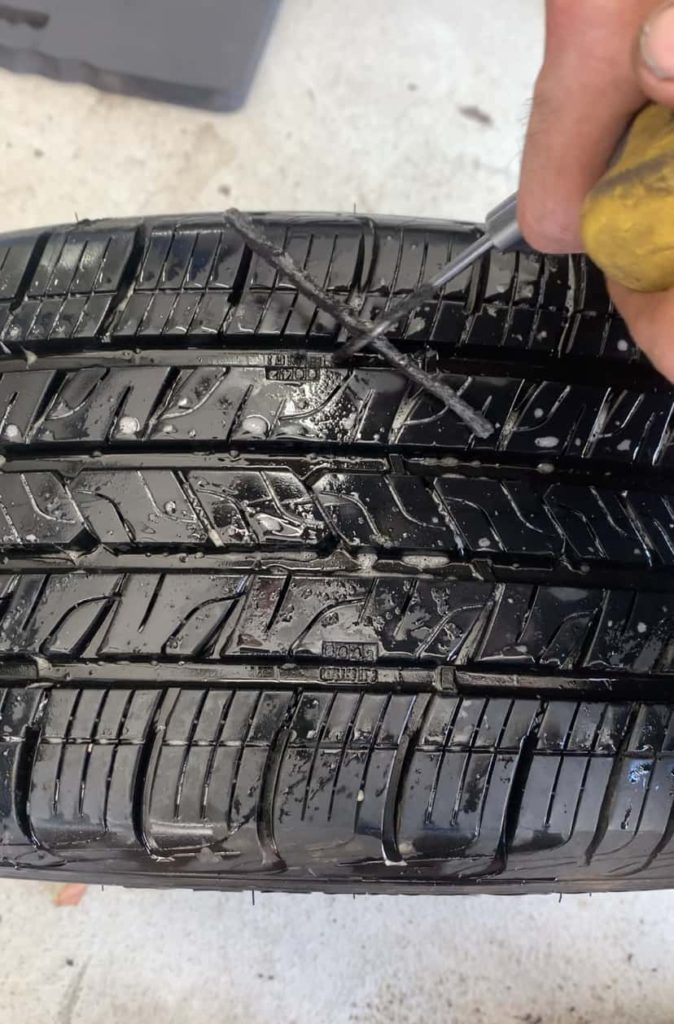How Does the Ford Edge Tire Pressure System Work?
The Ford Edge tire pressure monitoring system measures the tire pressure in each tire and displays a warning light if one or more tires is underinflated or if there is an issue with the system. The TPMS is made up of sensors, a TPMS receiver module and a main computer or ECU.
Ford Edge TPMS Components:
Tire Pressure Sensors: Located inside each tire and attached to the base of each valve stem. The sensors continuously measure the pressure and temperature within its tire. Each sensor has its own circuit board and battery-powered transmitter.
Data Transmission: When the Ford Edge is in motion or when a change of pressure has been detected, the sensors transmit the data wirelessly. These transmissions are sent via Radio Frequency (RF) signals. Ford uses both, 315 Mhz and 433 Mhz sensors.
TPMS Receiver Module: The car is equipped with a receiver module that captures the data sent from each sensor. This module is responsible for interpreting the signals and forwarding the information to the Electronic Control Unit (ECU).
Electronic Control Unit (ECU): This is essentially the brain of the vehicle and it controls numerous systems. It receives the tire pressure information from the TPMS receiver module and determines whether the pressure is within the acceptable range set by Ford. The range threshold is 15-20% below the recommended pressure, the warning light will be triggered.
Warning Light: If the ECU determines that the pressure in one or more tires is too low, it will trigger a warning light on the dashboard as well as display a message. The universal low tire pressure warning light is a yellow or orange exclamation mark. The Ford Edge will also display a “Low Tire Pressure” message and let you know through the information display which tire is low on pressure.
Ford Edge Low Tire Pressure Light Reset Procedure
Use a tire pressure gauge and tire inflator to check and adjust the tire pressure of each tire. Set all 4 tires to the exact cold recommended pressures when the tires are cold.
After all 4 tires have been set to the recommended pressure, the Ford Edge needs to be driven. Drive it at speeds over 20 Mph for at least a few minutes.
The tire light will reset and turn off white driving.
How to Retrain Ford Edge Tire Pressure Sensors (2015-2024)
Each tire pressure sensor has its own unique ID number so that the Ford Edge ECU knows the position of each wheel. For example, the ECU matches ID 1234 to the front left wheel position. This means that after a tire rotation, after any tire or wheel service, or if a pressure sensor is replaced/serviced, the tire pressure sensors must be retrained on their new wheel positions. To retrain the Ford Edge tire pressure sensors follow these steps:
Before training the sensors, drive the Ford Edge For a few minutes at speeds over 20 Mph. After whatever wheel or tire service has been completed, take the car for a quick drive.
Turn the engine engine and power OFF.
Turn the key to the ON position or press the push start twice without your foot on brake. (Engine Off, electricity On)
With the car electricity ON, press the hazard lights button on and off 3 times within 10 seconds.
If you’ve completed the first 4 steps successfully, the Edge will go into “Reset/Train Mode”, and you’ll hear the horn beep once.
The tire pressure light (yellow exclamation point) will start blinking and a warning message on the information display will suggest which sensor needs to be trained. (We recommend training all the sensors)
If the Edge does not go into “Training Mode”, repeat steps 1-6.
Get out of the car and remove the valve cap from the front left tire (driver side front wheel). Gently push the valve stem core in and start releasing air from the tire. (You will hear a hiss sound)
When you hear the horn beep, stop releasing air.
A single horn beep confirms that the sensor ID number has been learned by the ECU for that wheel position. (front left sensor is now learned as the front left wheel)
Move onto the front right tire (passenger side front). Release air until the horn beeps.
Move onto the rear right tire (passenger side rear). Release air until the horn beeps.
Move onto the rear left tire (driver side rear). Release air until the horn beeps.
After training all 4 tires, check and adjust all 4 tires’ pressure back to the recommended cold pressure values. Always set the pressures when the tires are cold.
The information display screen inside the Edge will now say “training complete”
Select OK
Tire Pressure Sensors Retraining Tips:
If you hear the horn beep twice during the training process, repeat the entire procedure.
Perform the retraining process at least 3 feet away from other Ford vehicles, radio equipment and antenna.
Don’t wait more than 2 minutes between training each tire pressure sensor. (Train one sensor, move onto the next sensor, do not wait between training sensors)
Always perform the sensor training process in the following order: front left wheel, front right wheel, rear right wheel, rear left wheel.
Put the valve caps back on to prevent dirt from getting in the valve stem.
What Will Cause the ford Edge Low Tire Pressure Light to Turn On?
Low tire pressure
High tire pressure
Tire pressure leak
Wheel missing tire pressure sensor (spare tire)
Damaged, faulty or low battery tire pressure sensor
Faulty TPMS receiver module
Radio frequency interference from other Ford vehicles or electronics
Weather or altitude change
Vehicle weight overload
Diagnosing the Ford Edge Tire Light
When the Ford Edge TPMS light turns on it means there is a problem. This could mean one or more tires is low on air or one or more tire pressure sensors aren’t communicating with the TPMS receiver module or ECU properly. If you have attempted the Ford edge tire pressure reset procedure and the tire pressure sensor retraining and the tire light is still on, here are 6 more options/solutions to try:
Solution 1: Is There a Tire Losing Air Pressure?
The primary cause for the activation of the low tire pressure warning light in the Ford Edge is usually a loss of air in one of the tires. To confirm this is the issue, take the following steps:
Measure the air pressure in all four tires, identifying the one that is under-inflated.
Inflate the low tire to its recommended pressure level.
Drive your Ford Edge at speeds above 20 mph for 3 minutes.
If after inflating the tire, the warning light deactivates but then reappears later—whether it’s after a few minutes, hours, or even days—this is a strong indication that there’s a leak in that specific tire. You’ve now pinpointed the problematic tire; proceed to solution 6 to locate the source of the leak.
Solution 2: Erase the Diagnostic Trouble Codes From the Ford Edge ECU
Every time the tire pressure warning light activates on your Ford Edge, the vehicle’s Electronic Control Unit (ECU) logs this event, storing it as a Diagnostic Trouble Code (DTC). To erase these codes, including those related to low tire pressure, you can try performing a hard reset on the ECU. Start by ensuring the car and all its electrical components are turned off. Open the hood and disconnect the negative terminal from the main 12V battery. Pause for a moment before reattaching the terminal. The Edge will enter a “relearning” mode and should be driven to complete this process. We recommend driving the Ford Edge for about 30 minutes at a consistent speed of 50 mph. Note: If the low tire pressure light goes off after the battery reconnection but reactivates during your drive, it indicates that either one or more tire pressure sensors are defective and need replacement, or you have a tire leak.
Solution 3: Find the Faulty Tire Pressure Sensor
If you suspect that one or more of the tire pressure sensors are either running low on battery or are malfunctioning, you can individually assess the status of each sensor using a Tire Pressure Monitoring System diagnostic tool. I’ve had experience with various brands and models of these tools and the procedure remains consistent. To start, connect the tool to your Ford Edge via the OBD2 port. Then position the tool in front of the tire valve on the front left wheel. Choose the “test” or “trigger” option on the device and wait for its response. Repeat this process for the remaining three sensors and review the tool’s findings. If any sensor shows a “low” battery status, fails to register, or doesn’t successfully connect with the TPMS tool, it’s likely that specific sensor needs to be replaced.
Solution 4: Reactivate a Non-responsive Tire Sensor
If you’ve gone through the sensor retraining procedures for your Ford Edge and find that one or more sensors still aren’t functioning, you may try to “activate” a dormant or non-responsive sensor. To do this, first release approximately 15 Psi of air from the problematic tire by gently depressing the valve stem core. Wait a few moments and then inflate the tire to 5 Psi above the manufacturer-recommended level. For instance, if the recommended pressure is 36 Psi, inflate it to 41 Psi. After over inflating the tire, drive your Ford Edge for a couple of minutes at speeds exceeding 20 mph. Then, stop and park the vehicle and adjust the tire pressure back to its recommended level. Once adjusted, take the SUV for another brief drive while maintaining speeds above 20 mph to complete the process.
Solution 5: The Low Tire Light Turns On and Off By Itself
Each time you start your car after it’s been sitting parked, the tires are considered “cold,” which can lead to a slight decrease in tire pressure. This is often enough to trigger the low-pressure warning light. However, as you begin to drive and the tires warm up, the pressure naturally increases which can cause the warning light to turn off. To resolve this issue it’s best to check and adjust the tire pressure on your Ford Edge when the tires are cold. Doing so will provide the most accurate pressure reading and prevent the warning light from constantly activating and deactivating.
Solution 6: How to Find a Tire Leak
If you’ve identified which tire is losing air, there’s a straightforward method to pinpoint the location of the leak. You’ll need four items: a spray bottle, water, soap, and a tire inflator. Start by inflating the under-inflated tire to at least it’s recommended pressure level. Then, prepare a soapy mixture in the spray bottle and ensure a generous amount of soap is included (you can use a product like Windex). Proceed to thoroughly spray down the tire with this soapy solution, making sure to cover the entire surface area including the valve stem. Once the tire is wet, closely inspect it for the appearance of small bubbles. These bubbles indicate the leak’s location. If you notice lots of air bubbles then you’ve successfully located the leak.
Ford Edge Tire Pressure Sensor Batteries
Every wheel of the Ford Edge comes equipped with an individual tire pressure sensor, each powered by its own silver-oxide battery. The battery is directly soldered to the sensor’s circuit board and encased in a plastic housing. Due to this design, a low battery cannot be swapped out; instead the entire sensor must be removed and replaced. Generally the lifespan of each sensor ranges from 5 to 10 years or approximately 100,000 miles.
Understanding The ford Edge Tires
How Does the Air Temperature Affect the Ford Edge Tire Pressure?
Fluctuations in air temperature and weather significantly impact the tire pressure of the Ford Edge. Warmer conditions cause the air inside the tires to expand, leading to higher tire pressure. In contrast, colder weather contracts the air and results in lower tire pressure. This interplay between temperature and weather can potentially lead to overinflation on hot days or underinflation on cold days both of which will cause tire pressure monitoring system lights. A rule of thumb is that for every 10-12 degree (F) change in temperature, the tire pressure will also change by 1-2 Psi.
How to Manually Check Tire Pressure
Preparation: Park your Ford Edge on a level surface and ensure it has been stationary for a few hours, allowing the tires to cool down. We recommend using a digital tire pressure gauge.
Remove Valve Cap: Unscrew the plastic cap from the valve stem and set it aside somewhere safe. This exposes the valve core, which controls the airflow.
Using the Gauge: Press the tire pressure gauge onto the valve stem firmly. You might hear a slight hiss of air escaping – this is normal.
Reading Pressure: The gauge will display the current tire pressure on its screen.
Adjust Pressure: If the reading is below the recommended pressure you’ll need to add air and if it’s too high you’ll need to release some air. To release air gently press the valve core until you hear a release of air.
Recheck Pressure: After adjusting the pressure, recheck it with the digital gauge to ensure it matches the exact recommended level.
Repeat for Other Tires: Repeat the process for all four tires of your Ford Edge.
Replace Valve Cap: Once you’ve checked and adjusted all the tires, screw the plastic valve caps back onto the valve stems to protect them from dust and debris.
NOTE: The spare tire does not have a sensor in it so this tire will not cause the tire light to turn on unless mounted on the Ford Edge.
Why Proper Tire Inflation Matters in the Ford Edge?
Optimal Fuel Efficiency: Proper tire pressure in the Ford Edge ensures maximum miles per gallon. This also means less rolling resistance aka friction, which leads to lower CO2 emissions.
Enhanced Handling: Correct pressure levels contribute to better steering response and cornering capabilities.
Reduced Tire Wear: Adequate tire pressure prolongs the lifespan of your tires by ensuring even tread wear. Overfilled tires wear out in the middle of the tread and underfilled tires wear out on the outer edges of the tread. Proper air pressure prevents premature tire replacements.
Safety Measures: Properly inflated tires minimize the risk of blowouts and tread separation.
Improved Traction: Optimal tire pressure helps in maintaining better contact with the road which is essential in slippery or adverse weather conditions.
Optimized Load Carrying: The Ford Edge is often used for hauling or towing; correct tire pressure ensures you get the maximum load-carrying capacity without compromising safety.
Common Ford Edge Tire Pressure Questions
Is It Safe to Drive the Ford Edge With the Tire Light On?
The first thing to be done when/if the low tire pressure light turns on is to pull over and check the tire pressure. Driving with the tire pressure light on is generally not safe. To truly know how safe it is you must determine why the tire light is on. Once you’ve diagnosed the problem then you can decide how safe it is.
Why is the Tire Light Flashing?
The tire light flashes when one or more of the tire pressure sensors loses connection or stops communicating with the Ford Edge TPMS receiver module or ECU. This is commonly referred to as a TPMS malfunction indicator. An example of this is when you drive with the spare tire on. The spare tire in the Ford Edge does not have a tire pressure sensor inside so the TPMS receiver module has nothing to communicate with. This will cause a TPMS malfunction because the ECU cannot receive tire pressure data from that wheel because there isn’t a sensor there. The same thing will happen when a tire pressure sensor battery is low or depleted and stops communicating with the TPMS receiver module.
Are Tire Plugs Reliable for Fixing Tire Punctures?
Yes tire plugs are extremely reliable at fixing punctured tires and they can last for the life of the tire. I have been using tire plugs on my own personal vehicles as well as customer vehicles and have no complaints. Only ever use tire plugs on the tread of the tire.
Do Tire Sealants Damage Tire Sensors?
Yes tire sealants can damage tire pressure sensors as well as cause the tire to be imbalanced. We recommend using tire sealants only as a last resort option.
How to Switch the Tire Pressure Units
Using the steering wheel controls:
Select Settings in the menu and press the OK button.
Select Display Setup and press the OK button.
Select Tire Pressure and press the OK button.
Choose the desired Tire Pressure Unit. (Psi, kPa, Etc. Psi is standard)
Checking Warm Tires Tire Pressure
If the tire pressure in the Ford Edge is adjusted after the car has been driven, the tires are hot. When the tires are warm or hot, the tire pressure will naturally increase by about 4 Psi. For example, if you measure the tire pressure when the tires are hot and the gauge shows 35 Psi, the cold pressure is actually 31 Psi. This is why it’s recommended to check and adjust tire pressure when the tires are cold.
Everything in this article is applicable to all Ford Edge models and versions including the Ford Edge SE, SEL, ST-Line, Titanium, and ST.
Please note that this blog post contains Amazon affiliate links. This means that if you make a purchase through one of these links, we at TPMSRESET.COM may earn a small commission at no extra cost to you. We only recommend products that we personally use and believe in. Thank you for supporting us.

